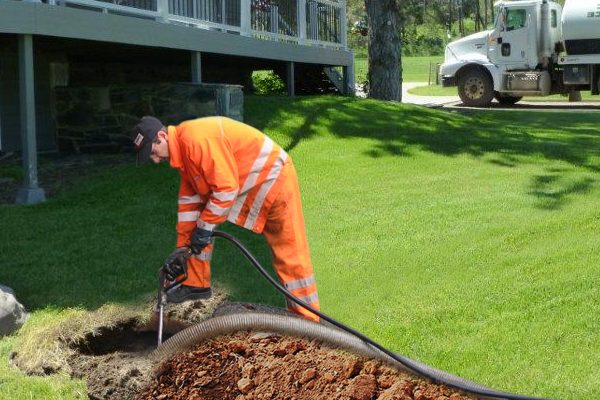When wastewater flows into your septic tank, bacteria break down some of the waste. Heavy solids settle to the bottom to form a layer of sludge. Oils and grease float to the top to become a layer of scum. The liquid in the middle is called effluent.
The liquid then flows through drainage pipes in your yard. This system helps keep sewage out of drinking water wells and local waterways. For more information, Click Here to proceed.

Septic tank systems work with natural and mechanical processes to remove disease-causing bacteria, organic matter and most nutrients. The pre-treated wastewater is then released into the ground through a pipe called a drain field or leach field. It slowly seeps into the underlying soil and waterways, where natural filtering processes remove the rest of the water waste and nutrient material.
A septic tank is an underground concrete or plastic container that collects and holds household waste, which includes gray wastewater from kitchens and latrines and black wastewater from bathrooms and laundry rooms. The tanks are available in different sizes to suit a home’s needs. Some are made with steel, while others are manufactured from polyethylene. Regardless of material, the septic tank is designed to be durable and resistant to corrosion.
The septic tank has two pipes for inlet and outlet. The inlet pipe transports the wastewater from household drains and toilets into the septic tank. The septic tank contains a thick layer of solid waste known as sludge and a thin layer of clear liquid known as effluent. Bacteria in the septic tank breaks down the solid waste and liquefies the effluent.
After the septic tank treats the wastewater, the inlet and outlet pipes transport it into the drain field. The septic tank has perforated pipes set in trenches of gravel in the yard. As the wastewater seeps through the drain field, it is treated again by bacterial and natural filtering processes.
To keep a septic tank healthy, it’s important to limit the amount of food that goes into the drains. Using garbage disposals can overload the system with large amounts of solid waste that can’t break down and can cause the septic tank to overflow. It’s also important to use household cleaners and disinfectants sparingly, because they can disrupt the bacteria that works to break down solid waste in a septic tank. In addition, the chemicals can wash away beneficial bacteria in the septic system, leading to a less effective septic tank and clogged drains. You can reduce the amount of solid waste in a septic tank by having a professional install an effluent filter that traps suspended solids before it leaves the septic tank.
As the wastewater passes through septic tanks and drain fields, bacteria degrade or break down organic waste. This process makes the water safe for disposal through pipes into the soil, where it is further purified by the earth. However, the system can be contaminated with pathogenic or disease-causing bacteria, viruses, and other contaminants if not properly maintained.
Failing septic systems discharge bacteria, fungus, and other toxic substances into nearby waterways or groundwater. These contaminants can contaminate drinking water wells and harm fish, plants, and animals. Excess nutrients such as nitrogen and phosphorus from failing septic systems also contribute to water pollution by fueling algae growth that uses up oxygen and harms aquatic organisms.
To prevent these problems:
- Have the septic tank pumped every few years and pump out sludge from the septic system regularly as needed.
- Avoid putting intoxicants, chemicals, paints, oils, and grease into the septic system.
- Use the garbage disposal sparingly, and only put trash in it that is biodegradable.
- Do not flush items that will clog the pipes, like coffee grounds, eggshells, floss, medications, and produce stickers.
- Use toilet paper labeled as septic safe or extra-ply toilet tissue; wet wipes are not septic friendly and should go in the trash.
A septic tank that is too full or with too much sludge in it will force wastewater out prematurely and clog the drain field. Maintaining the right septic tank volume is essential to protecting the system and reducing maintenance costs.
Maintaining proper water flow through the septic system is important to prevent overflows that can enter the home and cause flooding, structural damage, and other problems. Water-saving fixtures and appliances, such as showerheads and faucets with low flow rates and high-efficiency washers, reduce the load on the septic system.
Keep grass and other plants away from the septic tank and drainfield; this will help to limit the amount of solids that flow into the absorption field. Also, do not drive or park cars or heavy equipment on the drainfield; this can compact the soil and reduce its ability to filter wastes out of the groundwater.
Many people don’t realize that wastewater can carry pathogens that can cause illness. Failing septic tanks often release sewage into the soil, which can create an environment where bacteria can thrive. The waste can also contaminate drinking water, which is particularly hazardous for infants and elderly individuals.
A septic tank serves as a settling basin where solid waste collects and breaks down over time through natural bacterial decomposition. Some of the waste liquefies and floats to the top as semi-solid scum, while heavy waste accumulates in the bottom as a layer of sludge. The middle layer of filtered liquid sewage, known as effluent, exits the tank through various distribution drainage pipes into a drain field or leach field for filtration into the soil.
Wastewater contains a variety of bacteria and parasites that can pose health risks to humans and pets. These include protozoans, which multiply in untreated sewage and can cause amebic dysentery, as well as parasitic worms that can enter the body of people or animals who ingest the water. These infections can lead to severe diarrhea, which causes dehydration.
In addition, a failing septic system can send dangerous mold spores into homes, where they may grow in damp areas such as basements or bathrooms. These spores can cause sinus infections and other respiratory issues for those who are allergic to them.
Septic systems must be regularly inspected, cleaned and pumped to prevent the overflow of sludge. If this isn’t done, the septic tank can start to clog and overflow, leading to sewage backups in the home. It’s important for homeowners to avoid flushing chemicals down the drains, such as bleach, detergents and other household cleaners. These toxins can ruin the bacterial balance in a septic tank and pollute the surrounding groundwater.
Other hazardous substances that can be poured down drains include antifreeze, paint and gasoline. These substances can damage the septic tank and the pipes in the drainfield or leach field, and they can affect how well the septic system works. For this reason, it’s important for people to use natural products in their homes as much as possible. Adding bacteria additives that promote the growth of healthy microorganisms to the tank can help keep it working correctly.
As with any system, the best way to maintain your septic tank is through regular cleaning and inspection. A septic tank that doesn’t get cleaned regularly can quickly become clogged, resulting in wastewater back-up into the home. This can cause serious damage and is expensive to clean up and repair.
When the septic tank is working properly, it separates solid waste into three layers. The solids settle at the bottom of the tank, where microorganisms break them down. The middle layer is known as sludge and the top is a mixture of grease and oils, which floats on top. Bacteria in the septic tank breaks down these solids, allowing liquids to flow easily out of the tank.
Once the wastewater leaves your septic tank, it flows through underground perforated pipes into an absorption field. This is usually a gravel-filled area that’s partially buried in the ground. The water seeps into the soil, where bacteria further treat it before reaching groundwater.
Failing septic systems often leak contaminants into the surrounding soil and water sources, such as drinking wells and lakes. This is a serious health concern for both humans and pets, and it’s important to ensure your septic tank is in good condition.
A well-maintained septic tank is an added feature that can help raise the value of your property. Buyers will often examine the condition of major home systems and may reject a property that has a poorly functioning or unclean septic tank.
Regular septic tank maintenance is the only way to prevent clogs and other issues that can lead to a septic tank failure. The cost of regular septic tank cleaning is far less than the cost of repairs or replacement that can occur when the tank fails.
If you have questions about septic tank maintenance or a septic system repair, call an expert septic professional. They will be able to give you advice and recommend an appropriate schedule for cleaning, pumping, inspections and any other necessary services. Keep in mind that if you have an old or damaged septic system, it may need to be replaced entirely.
